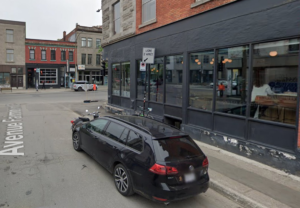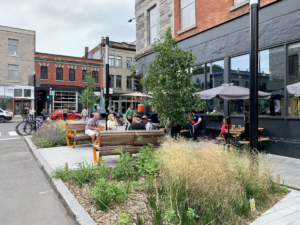Placemaking Interventions to Mitigate the Impacts of Climate Change
How small interventions can have big impacts in helping our communities live with the effects of climate change.
Jonathan Berk
Patronicity
How bad is it getting?
As the world sees increasingly warmer temperatures, new measures to mitigate the impacts of a changing climate are needed to save lives and increase the livability of our cities and towns. Around the world, we’re seeing extreme weather events with effects such as a rise in the occurrence of urban street flooding, with extreme flooding events causing trillions of dollars in damage annually. The United Kingdom experienced its worst heat wave on record in mid-July with highs topping 40 degrees Celsius for the first time ever, and a rise in dangerous heat waves across the world are killing thousands each year.
We know we need to reduce our collective carbon emissions to slow the long-term, most disastrous impacts of climate change. There’s a lot we need to be doing today on a granular local level to mitigate the impacts that communities everywhere are already facing.
Global Urbanization Trends
Today, the United Nations estimates that some 4.2 billion people live in cities around the world, over 55% of the global population, an urbanization trend that’s only expected to accelerate in the coming decades. Alongside that growing trend, we need to look at things we can do today to help mitigate the impacts of climate change immediately to save lives and make our urban and suburban environments more livable. Initiatives like tearing up pavement in favor of more permeable surfaces, as well as planting more trees and shrubs will not be enough to slow climate change, but it will help to decrease the impacts of extreme weather events making our cities more resilient places, improving the livability of our communities, and, in some cases, save lives.
Placemaking & Climate Mitigation
Planting more trees in urban areas can provide immediate benefits by sequestering carbon, filtering harmful pollutants out of the air emitted by buildings and vehicles. Trees can also provide extensive shade cover that can help keep city streets cooler and provide shade to area homes, decreasing cooling costs and limiting the need for more electricity usage. Streets with shade from trees can see air temperatures decrease by up to 15℉. Dense urban areas, and even suburban areas with excessive pavement, can take longer to cool in the evenings as pavement attracts and stores heat, releasing that warm air back into the neighborhood once the ambient air temperatures cool at night.
In big cities like Montreal and small towns like Batesville, Indiana, communities are looking for ways to break up large swaths of heat trapping concrete with more landscaping, shading, and spaces for people. In many places, they’ve taken existing street parking spaces and converted them into spaces for people to sit and enjoy the day, while also serving as spaces to mitigate the impacts of both extreme heat and extreme rain events.
As part of Montreal’s 2030 climate mitigation strategy, the city is looking to decrease the percentage of the City covered by concrete and invest in regreening activities like planting new trees and installing green bump outs like the one shown below. In an effort to cool the City while creating more permeable spaces during extreme rain events, thousands of new trees and shrubs will be planted across the City. These new green spaces will limit the amount of pavement attracting heat in the summer while creating new vibrant pedestrian spaces year-round.

A Montreal street before a green treatment (Source: Google Maps)

A Montreal Street after a green treatment. (Source AlexRMather on Twitter)
In New York City, a push is underway from community groups and advocacy organizations to have the City breakup large swaths of concrete streets to create more permeable surfaces to avoid or mitigate more frequent flash flood events like those that have tragically taken the lives of city residents in recent years.
In Batesville, Indiana, a small community space in the heart of Main Street was created by turning a formerly paved parking space into a public gathering space with seating, landscaping, and new trees. This new space creates a community destination in the downtown, reintroduces nature, and creates new opportunities to break up large swaths of concrete to develop more green, shady spaces to cool the surrounding area. Funding for this new space was provided by our CreatINg Places crowdgranting program in partnership with the Indiana Housing & Community Development Authority.
While major steps need to be taken today to limit the effects of climate change, we’re too late to stop some of the effects that we are beginning to see on a daily basis across the globe. Our communities will see more extreme weather events, heavier rainfalls, and more heat waves. We need to be creative in our thinking and ready to develop and implement strategies that mitigate the impacts of these climate events to improve the lives of our residents. Strategies, like these mentioned above, can not only mitigate the impacts of climate change, but also serve to boost livability in our cities, supporting thriving local economies that better connect our communities.
OEDA Congratulates Graduates of the 2025 Ohio Basic Economic Development Course
OEDA Congratulates Graduates of the 2025 Ohio Basic Economic Development Course DUBLIN, OH – The Ohio Economic Development Association (OEDA) proudly congratulates the more than 85 participants who successfully completed the 2025 Ohio Basic Economic Development Course...
OEDA Begins Strategic Planning Amid Record Growth + Program Expansion
FOR IMMEDIATE RELEASE RFP now open for OEDA’s next strategic plan; proposals due July 1, 2025 COLUMBUS, OH; Tuesday, June 3, 2025 — The Ohio Economic Development Association (OEDA) has released a Request for Proposals (RFP) to develop a new strategic plan, its first...
OEDA seeks host communities for its Annual Summit
For Immediate Release OEDA seeks host communities for its Annual Summit For the first time, location proposals sought for 400+ attendee conference COLUMBUS, OHIO – TUESDAY, NOVEMBER 12 – Today, the Ohio Economic Development Association (OEDA) announced that is...